Slice
type slice struct {
array unsafe.Pointer //指向存放数据的数组指针
len int //长度有多大
cap int //容量有多大
}
一个空的Slice
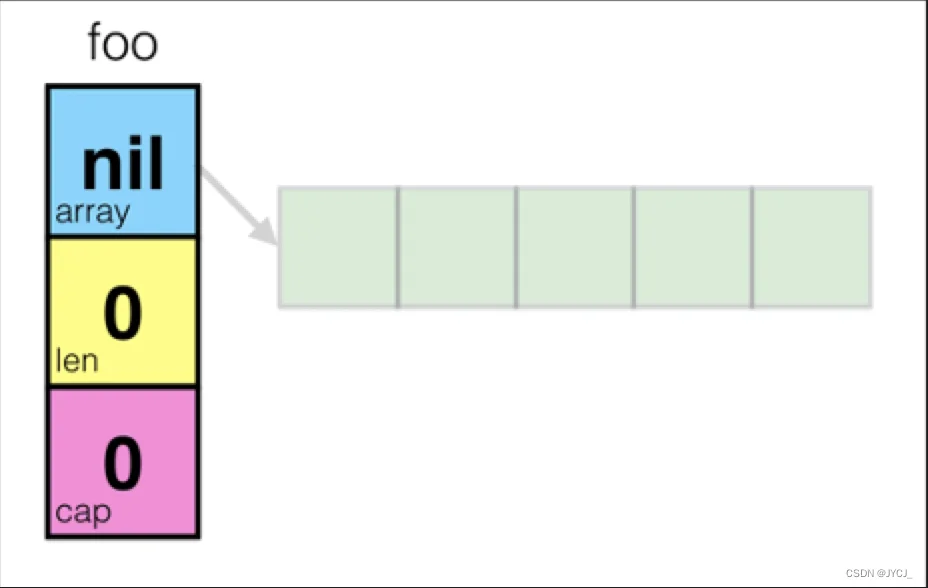
Q: 数组指针的问题?
slice的基本操作
foo = make([]int, 5)
foo[3] = 42
foo[4] = 100
bar := foo[1:4]
bar[1] = 99
理解示意图:
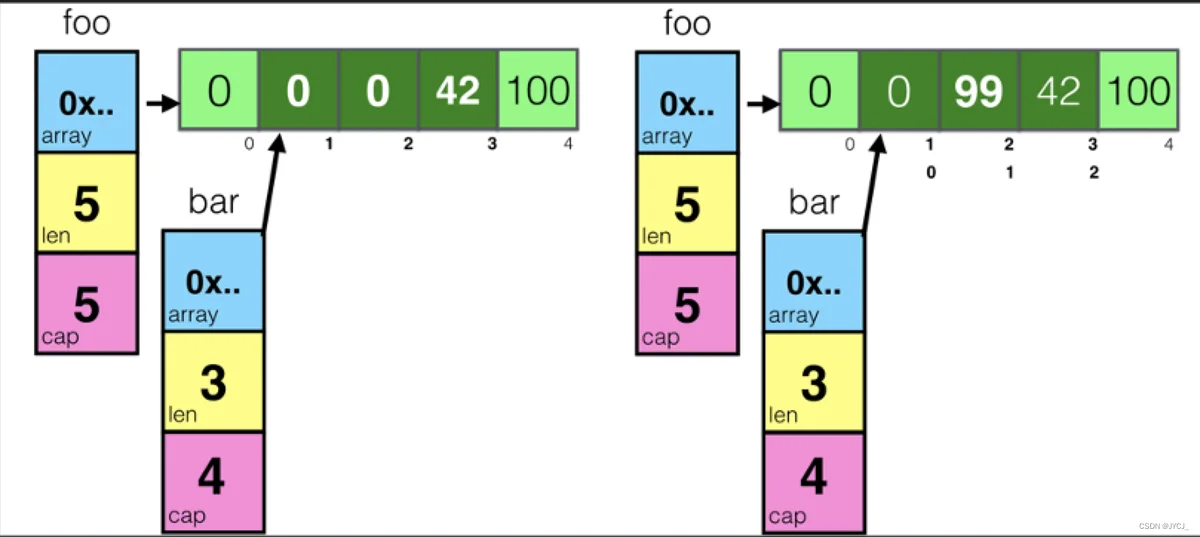
A:数据会发生共享
appand操作
a := make([]int, 32)
b := a[1:16]
a = append(a, 1)
a[2] = 42
示意图:
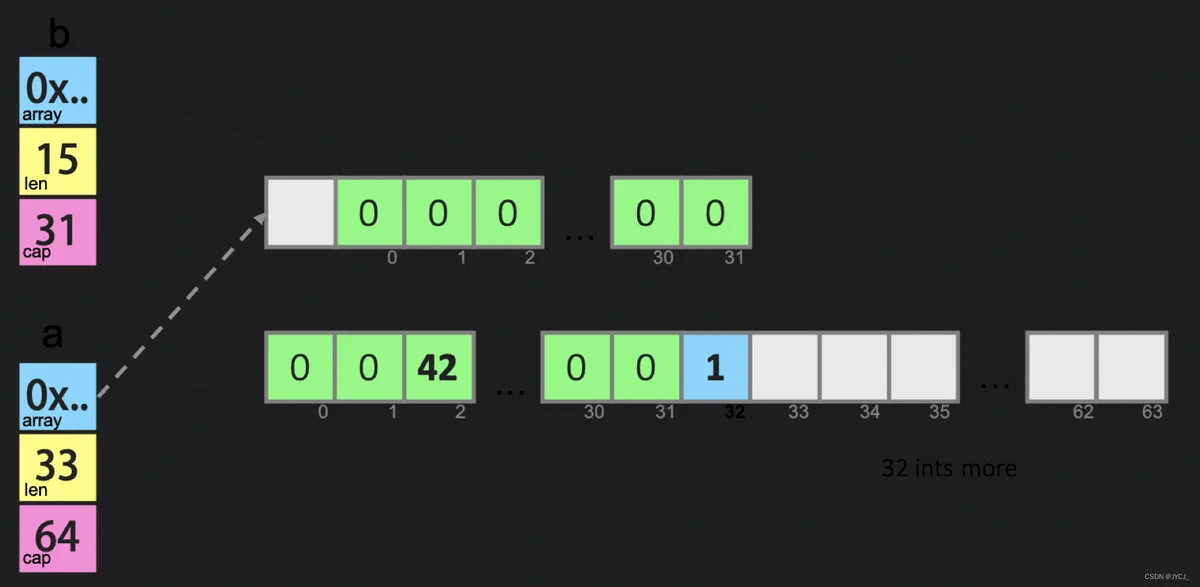
Q: append可能存在的问题
A: 数据被覆盖
func main() {
path := []byte("AAAA/BBBBBBBBB")
sepIndex := bytes.IndexByte(path,'/')
dir1 := path[:sepIndex]
dir2 := path[sepIndex+1:]
fmt.Println("dir1 =>",string(dir1)) //prints: dir1 => AAAA
fmt.Println("dir2 =>",string(dir2)) //prints: dir2 => BBBBBBBBB
dir1 = append(dir1,"suffix"...)
fmt.Println("dir1 =>",string(dir1)) //prints: dir1 => AAAAsuffix
fmt.Println("dir2 =>",string(dir2)) //prints: dir2 => uffixBBBB
}
示意图
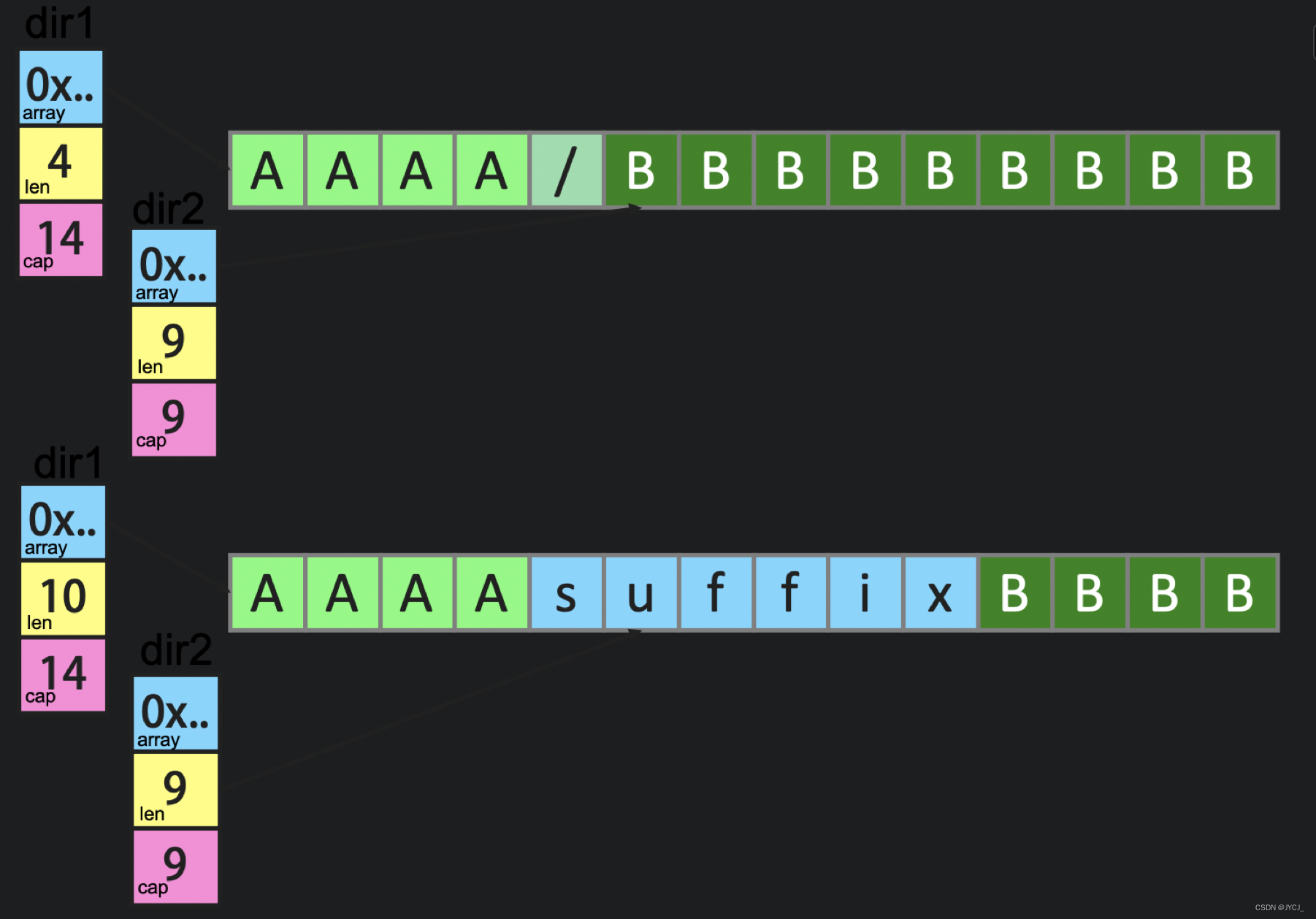
解决办法:
// 使用了 Full Slice Expression,最后一个参数叫“Limited Capacity”,于是,后续的 append() 操作会导致重新分配内存。
dir1 := path[:sepIndex:sepIndex]
接口编程
type Country struct {
Name string
}
type City struct {
Name string
}
type Printable interface {
PrintStr()
}
func (c Country) PrintStr() {
fmt.Println(c.Name)
}
func (c City) PrintStr() {
fmt.Println(c.Name)
}
c1 := Country {"China"}
c2 := City {"Beijing"}
c1.PrintStr()
c2.PrintStr()
结构体嵌入:
type WithName struct {
Name string
}
type Country struct {
WithName
}
type City struct {
WithName
}
type Printable interface {
PrintStr()
}
func (w WithName) PrintStr() {
fmt.Println(w.Name)
}
c1 := Country {WithName{ "China"}}
c2 := City { WithName{"Beijing"}}
c1.PrintStr()
c2.PrintStr()
比较好的做法
type Country struct {
Name string
}
type City struct {
Name string
}
type Stringable interface {
ToString() string
}
func (c Country) ToString() string {
return "Country = " + c.Name
}
func (c City) ToString() string{
return "City = " + c.Name
}
func PrintStr(p Stringable) {
fmt.Println(p.ToString())
}
d1 := Country {"USA"}
d2 := City{"Los Angeles"}
PrintStr(d1)
PrintStr(d2)
接口完整性检查
var _ Stringable = (*Country)(nil)
Functional Options
配置选项问题
type Server struct {
Addr string
Port int
Protocol string
Timeout time.Duration
MaxConns int
TLS *tls.Config
}
方案一:配置对象方案
type Config struct {
Protocol string
Timeout time.Duration
Maxconns int
TLS *tls.Config
}
type Server struct {
Addr string
Port int
Conf *Config
}
方案二:Builder 模式
User user = new User.Builder()
.name("Hao Chen")
.email("haoel@hotmail.com")
.nickname("左耳朵")
.build();
golang版
//使用一个builder类来做包装
type ServerBuilder struct {
Server
}
func (sb *ServerBuilder) Create(addr string, port int) *ServerBuilder {
sb.Server.Addr = addr
sb.Server.Port = port
//其它代码设置其它成员的默认值
return sb
}
func (sb *ServerBuilder) WithProtocol(protocol string) *ServerBuilder {
sb.Server.Protocol = protocol
return sb
}
func (sb *ServerBuilder) WithMaxConn( maxconn int) *ServerBuilder {
sb.Server.MaxConns = maxconn
return sb
}
func (sb *ServerBuilder) WithTimeOut( timeout time.Duration) *ServerBuilder {
sb.Server.Timeout = timeout
return sb
}
func (sb *ServerBuilder) WithTLS( tls *tls.Config) *ServerBuilder {
sb.Server.TLS = tls
return sb
}
func (sb *ServerBuilder) Build() (Server) {
return sb.Server
}
Functional Options(高阶函数)
type Option func(*Server)
func Protocol(p string) Option {
return func(s *Server) {
s.Protocol = p
}
}
func Timeout(timeout time.Duration) Option {
return func(s *Server) {
s.Timeout = timeout
}
}
func MaxConns(maxconns int) Option {
return func(s *Server) {
s.MaxConns = maxconns
}
}
func TLS(tls *tls.Config) Option {
return func(s *Server) {
s.TLS = tls
}
}
// 初始化
func NewServer(addr string, port int, options ...func(*Server)) (*Server, error) {
srv := Server{
Addr: addr,
Port: port,
Protocol: "tcp",
Timeout: 30 * time.Second,
MaxConns: 1000,
TLS: nil,
}
for _, option := range options {
option(&srv)
}
//...
return &srv, nil
}
反转控制
示例
type IntSet struct {
data map[int]bool
}
func NewIntSet() IntSet {
return IntSet{make(map[int]bool)}
}
func (set *IntSet) Add(x int) {
set.data[x] = true
}
func (set *IntSet) Delete(x int) {
delete(set.data, x)
}
func (set *IntSet) Contains(x int) bool {
return set.data[x]
}
实现 Undo 功能
type UndoableIntSet struct { // Poor style
IntSet // Embedding (delegation)
functions []func()
}
func NewUndoableIntSet() UndoableIntSet {
return UndoableIntSet{NewIntSet(), nil}
}
func (set *UndoableIntSet) Add(x int) { // Override
if !set.Contains(x) {
set.data[x] = true
set.functions = append(set.functions, func() { set.Delete(x) })
} else {
set.functions = append(set.functions, nil)
}
}
func (set *UndoableIntSet) Delete(x int) { // Override
if set.Contains(x) {
delete(set.data, x)
set.functions = append(set.functions, func() { set.Add(x) })
} else {
set.functions = append(set.functions, nil)
}
}
func (set *UndoableIntSet) Undo() error {
if len(set.functions) == 0 {
return errors.New("No functions to undo")
}
index := len(set.functions) - 1
if function := set.functions[index]; function != nil {
function()
set.functions[index] = nil // For garbage collection
}
set.functions = set.functions[:index]
return nil
}
Q: 这样存在什么问题?
这种方式最大的问题是,Undo 操作其实是一种控制逻辑,并不是业务逻辑,所以,在复用 Undo 这个功能时,是有问题的,因为其中加入了大量跟 IntSet 相关的业务逻辑。
反转依赖
控制逻辑
type Undo []func()
func (undo *Undo) Add(function func()) {
*undo = append(*undo, function)
}
func (undo *Undo) Undo() error {
functions := *undo
if len(functions) == 0 {
return errors.New("No functions to undo")
}
index := len(functions) - 1
if function := functions[index]; function != nil {
function()
functions[index] = nil // For garbage collection
}
*undo = functions[:index]
return nil
}
业务逻辑
type IntSet struct {
data map[int]bool
undo Undo
}
func NewIntSet() IntSet {
return IntSet{data: make(map[int]bool)}
}
func (set *IntSet) Undo() error {
return set.undo.Undo()
}
func (set *IntSet) Contains(x int) bool {
return set.data[x]
}
func (set *IntSet) Add(x int) {
if !set.Contains(x) {
set.data[x] = true
set.undo.Add(func() { set.Delete(x) })
} else {
set.undo.Add(nil)
}
}
func (set *IntSet) Delete(x int) {
if set.Contains(x) {
delete(set.data, x)
set.undo.Add(func() { set.Add(x) })
} else {
set.undo.Add(nil)
}
}
这个就是控制反转,不是由控制逻辑 Undo 来依赖业务逻辑 IntSet,而是由业务逻辑 IntSet 依赖 Undo 。这里依赖的是其实是一个协议,这个协议是一个没有参数的函数数组
map-reduce
业务示例
type Employee struct {
Name string
Age int
Vacation int
Salary int
}
var list = []Employee{
{"Hao", 44, 0, 8000},
{"Bob", 34, 10, 5000},
{"Alice", 23, 5, 9000},
{"Jack", 26, 0, 4000},
{"Tom", 48, 9, 7500},
{"Marry", 29, 0, 6000},
{"Mike", 32, 8, 4000},
}
相关的 Reduce、Fitler 函数
func EmployeeCountIf(list []Employee, fn func(e *Employee) bool) int {
count := 0
for i, _ := range list {
if fn(&list[i]) {
count += 1
}
}
return count
}
func EmployeeFilterIn(list []Employee, fn func(e *Employee) bool) []Employee {
var newList []Employee
for i, _ := range list {
if fn(&list[i]) {
newList = append(newList, list[i])
}
}
return newList
}
func EmployeeSumIf(list []Employee, fn func(e *Employee) int) int {
var sum = 0
for i, _ := range list {
sum += fn(&list[i])
}
return sum
}
各种自定义的统计示例
old := EmployeeCountIf(list, func(e *Employee) bool {
return e.Age > 40
})
fmt.Printf("old people: %d\n", old)
//old people: 2
no_vacation := EmployeeFilterIn(list, func(e *Employee) bool {
return e.Vacation == 0
})
fmt.Printf("People no vacation: %v\n", no_vacation)
//People no vacation: [{Hao 44 0 8000} {Jack 26 0 4000} {Marry 29 0 6000}]
total_pay := EmployeeSumIf(list, func(e *Employee) int {
return e.Salary
})
fmt.Printf("Total Salary: %d\n", total_pay)
//Total Salary: 43500
泛型 Map-Reduce
简单版
func Map(data interface{}, fn interface{}) []interface{} {
vfn := reflect.ValueOf(fn)
vdata := reflect.ValueOf(data)
result := make([]interface{}, vdata.Len())
for i := 0; i < vdata.Len(); i++ {
result[i] = vfn.Call([]reflect.Value{vdata.Index(i)})[0].Interface()
}
return result
}
健壮版的 Generic Map
func Transform(slice, function interface{}) interface{} {
return transform(slice, function, false)
}
func TransformInPlace(slice, function interface{}) interface{} {
return transform(slice, function, true)
}
func transform(slice, function interface{}, inPlace bool) interface{} {
//check the `slice` type is Slice
sliceInType := reflect.ValueOf(slice)
if sliceInType.Kind() != reflect.Slice {
panic("transform: not slice")
}
//check the function signature
fn := reflect.ValueOf(function)
elemType := sliceInType.Type().Elem()
if !verifyFuncSignature(fn, elemType, nil) {
panic("trasform: function must be of type func(" + sliceInType.Type().Elem().String() + ") outputElemType")
}
sliceOutType := sliceInType
if !inPlace {
sliceOutType = reflect.MakeSlice(reflect.SliceOf(fn.Type().Out(0)), sliceInType.Len(), sliceInType.Len())
}
for i := 0; i < sliceInType.Len(); i++ {
sliceOutType.Index(i).Set(fn.Call([]reflect.Value{sliceInType.Index(i)})[0])
}
return sliceOutType.Interface()
}
func verifyFuncSignature(fn reflect.Value, types ...reflect.Type) bool {
//Check it is a funciton
if fn.Kind() != reflect.Func {
return false
}
// NumIn() - returns a function type's input parameter count.
// NumOut() - returns a function type's output parameter count.
if (fn.Type().NumIn() != len(types)-1) || (fn.Type().NumOut() != 1) {
return false
}
// In() - returns the type of a function type's i'th input parameter.
for i := 0; i < len(types)-1; i++ {
if fn.Type().In(i) != types[i] {
return false
}
}
// Out() - returns the type of a function type's i'th output parameter.
outType := types[len(types)-1]
if outType != nil && fn.Type().Out(0) != outType {
return false
}
return true
}
健壮版的 Generic Reduce
func Reduce(slice, pairFunc, zero interface{}) interface{} {
sliceInType := reflect.ValueOf(slice)
if sliceInType.Kind() != reflect.Slice {
panic("reduce: wrong type, not slice")
}
len := sliceInType.Len()
if len == 0 {
return zero
} else if len == 1 {
return sliceInType.Index(0)
}
elemType := sliceInType.Type().Elem()
fn := reflect.ValueOf(pairFunc)
if !verifyFuncSignature(fn, elemType, elemType, elemType) {
t := elemType.String()
panic("reduce: function must be of type func(" + t + ", " + t + ") " + t)
}
var ins [2]reflect.Value
ins[0] = sliceInType.Index(0)
ins[1] = sliceInType.Index(1)
out := fn.Call(ins[:])[0]
for i := 2; i < len; i++ {
ins[0] = out
ins[1] = sliceInType.Index(i)
out = fn.Call(ins[:])[0]
}
return out.Interface()
}
健壮版的 Generic Filter
func Filter(slice, function interface{}) interface{} {
result, _ := filter(slice, function, false)
return result
}
func FilterInPlace(slicePtr, function interface{}) {
in := reflect.ValueOf(slicePtr)
if in.Kind() != reflect.Ptr {
panic("FilterInPlace: wrong type, " +
"not a pointer to slice")
}
_, n := filter(in.Elem().Interface(), function, true)
in.Elem().SetLen(n)
}
var boolType = reflect.ValueOf(true).Type()
func filter(slice, function interface{}, inPlace bool) (interface{}, int) {
sliceInType := reflect.ValueOf(slice)
if sliceInType.Kind() != reflect.Slice {
panic("filter: wrong type, not a slice")
}
fn := reflect.ValueOf(function)
elemType := sliceInType.Type().Elem()
if !verifyFuncSignature(fn, elemType, boolType) {
panic("filter: function must be of type func(" + elemType.String() + ") bool")
}
var which []int
for i := 0; i < sliceInType.Len(); i++ {
if fn.Call([]reflect.Value{sliceInType.Index(i)})[0].Bool() {
which = append(which, i)
}
}
out := sliceInType
if !inPlace {
out = reflect.MakeSlice(sliceInType.Type(), len(which), len(which))
}
for i := range which {
out.Index(i).Set(sliceInType.Index(which[i]))
}
return out.Interface(), len(which)
}
注意:
- 使用反射来做这些东西会有一个问题,那就是代码的性能会很差。所以,上面的代码不能用在需要高性能的地方
- 有没有什么改进的办法?
Go Generation
Go 语言的代码生成主要还是用来解决编程泛型的问题。泛型编程主要是解决这样一个问题:因为静态类型语言有类型,所以,相关的算法或是对数据处理的程序会因为类型不同而需要复制一份,这样会导致数据类型和算法功能耦合。
要玩 Go 的代码生成,你需要三个东西:
- 一个函数模板,在里面设置好相应的占位符;
- 一个脚本,用于按规则来替换文本并生成新的代码;
- 一行注释代码。
package PACKAGE_NAME
type GENERIC_NAMEContainer struct {
s []GENERIC_TYPE
}
func NewGENERIC_NAMEContainer() *GENERIC_NAMEContainer {
return &GENERIC_NAMEContainer{s: []GENERIC_TYPE{}}
}
func (c *GENERIC_NAMEContainer) Put(val GENERIC_TYPE) {
c.s = append(c.s, val)
}
func (c *GENERIC_NAMEContainer) Get() GENERIC_TYPE {
r := c.s[0]
c.s = c.s[1:]
return r
}
函数生成脚本
#!/bin/bash
set -e
SRC_FILE=${1}
PACKAGE=${2}
TYPE=${3}
DES=${4}
#uppcase the first char
PREFIX="$(tr '[:lower:]' '[:upper:]' <<< ${TYPE:0:1})${TYPE:1}"
DES_FILE=$(echo ${TYPE}| tr '[:upper:]' '[:lower:]')_${DES}.go
sed 's/PACKAGE_NAME/'"${PACKAGE}"'/g' ${SRC_FILE} | \
sed 's/GENERIC_TYPE/'"${TYPE}"'/g' | \
sed 's/GENERIC_NAME/'"${PREFIX}"'/g' > ${DES_FILE}
代码生成
//go:generate ./gen.sh ./template/container.tmp.go gen uint32 container
func generateUint32Example() {
var u uint32 = 42
c := NewUint32Container()
c.Put(u)
v := c.Get()
fmt.Printf("generateExample: %d (%T)\n", v, v)
}
//go:generate ./gen.sh ./template/container.tmp.go gen string container
func generateStringExample() {
var s string = "Hello"
c := NewStringContainer()
c.Put(s)
v := c.Get()
fmt.Printf("generateExample: %s (%T)\n", v, v)
}
根据模版文件生成的代码:
package gen
type Uint32Container struct {
s []uint32
}
func NewUint32Container() *Uint32Container {
return &Uint32Container{s: []uint32{}}
}
func (c *Uint32Container) Put(val uint32) {
c.s = append(c.s, val)
}
func (c *Uint32Container) Get() uint32 {
r := c.s[0]
c.s = c.s[1:]
return r
}
新版Filter
package PACKAGE_NAME
type GENERIC_NAMEList []GENERIC_TYPE
type GENERIC_NAMEToBool func(*GENERIC_TYPE) bool
func (al GENERIC_NAMEList) Filter(f GENERIC_NAMEToBool) GENERIC_NAMEList {
var ret GENERIC_NAMEList
for _, a := range al {
if f(&a) {
ret = append(ret, a)
}
}
return ret
}
如何使用?
type Employee struct {
Name string
Age int
Vacation int
Salary int
}
//go:generate ./gen.sh ./template/filter.tmp.go gen Employee filter
func filterEmployeeExample() {
var list = EmployeeList{
{"Hao", 44, 0, 8000},
{"Bob", 34, 10, 5000},
{"Alice", 23, 5, 9000},
{"Jack", 26, 0, 4000},
{"Tom", 48, 9, 7500},
}
var filter EmployeeList
filter = list.Filter(func(e *Employee) bool {
return e.Age > 40
})
fmt.Println("----- Employee.Age > 40 ------")
for _, e := range filter {
fmt.Println(e)
}
filter = list.Filter(func(e *Employee) bool {
return e.Salary <= 5000
})
fmt.Println("----- Employee.Salary <= 5000 ------")
for _, e := range filter {
fmt.Println(e)
}
}
开源template库
修饰器
HTTP 相关的一个示例
package main
import (
"fmt"
"log"
"net/http"
"strings"
)
func WithServerHeader(h http.HandlerFunc) http.HandlerFunc {
return func(w http.ResponseWriter, r *http.Request) {
log.Println("--->WithServerHeader()")
w.Header().Set("Server", "HelloServer v0.0.1")
h(w, r)
}
}
func hello(w http.ResponseWriter, r *http.Request) {
log.Printf("Recieved Request %s from %s\n", r.URL.Path, r.RemoteAddr)
fmt.Fprintf(w, "Hello, World! "+r.URL.Path)
}
func main() {
http.HandleFunc("/v1/hello", WithServerHeader(hello))
err := http.ListenAndServe(":8080", nil)
if err != nil {
log.Fatal("ListenAndServe: ", err)
}
}
有写 HTTP 响应头的,有写认证 Cookie 的,有检查认证 Cookie 的,有打日志的……
http.HandleFunc("/v1/hello", WithServerHeader(WithAuthCookie(hello))) http.HandleFunc("/v2/hello", WithServerHeader(WithBasicAuth(hello))) http.HandleFunc("/v3/hello", WithServerHeader(WithBasicAuth(WithDebugLog(hello)))) err := http.ListenAndServe(":8080", nil) if err != nil { log.Fatal("ListenAndServe: ", err) }
多个修饰器的 Pipeline
type HttpHandlerDecorator func(http.HandlerFunc) http.HandlerFunc
func Handler(h http.HandlerFunc, decors ...HttpHandlerDecorator) http.HandlerFunc {
for i := range decors {
d := decors[len(decors)-1-i] // iterate in reverse
h = d(h)
}
return h
}
http.HandleFunc("/v4/hello", Handler(hello,
WithServerHeader, WithBasicAuth, WithDebugLog))
Pipeline
Channel 转发函数
func echo(nums []int) <-chan int {
out := make(chan int)
go func() {
for _, n := range nums {
// 怎么定义你的业务逻辑(平方函数sq,过滤奇数函数odd,求和函数sum 等等)
out <- n
}
close(out)
}()
return out
}
类似于我们执行了 Unix/Linux 命令: echo $nums | sq | sum
type EchoFunc func ([]int) (<- chan int)
type PipeFunc func (<- chan int) (<- chan int)
func pipeline(nums []int, echo EchoFunc, pipeFns ... PipeFunc) <- chan int {
ch := echo(nums)
for i := range pipeFns {
ch = pipeFns[i](ch)
}
return ch
}
Fan in/Out
动用 Go 语言的 Go Routine 和 Channel 还有一个好处,就是可以写出 1 对多,或多对 1 的 Pipeline,也就是 Fan In/ Fan Out
func makeRange(min, max int) []int {
a := make([]int, max-min+1)
for i := range a {
a[i] = min + i
}
return a
}
func main() {
nums := makeRange(1, 10000)
in := echo(nums)
const nProcess = 5
var chans [nProcess]<-chan int
for i := range chans {
chans[i] = sum(prime(in))
}
for n := range sum(merge(chans[:])) {
fmt.Println(n)
}
}
流程:
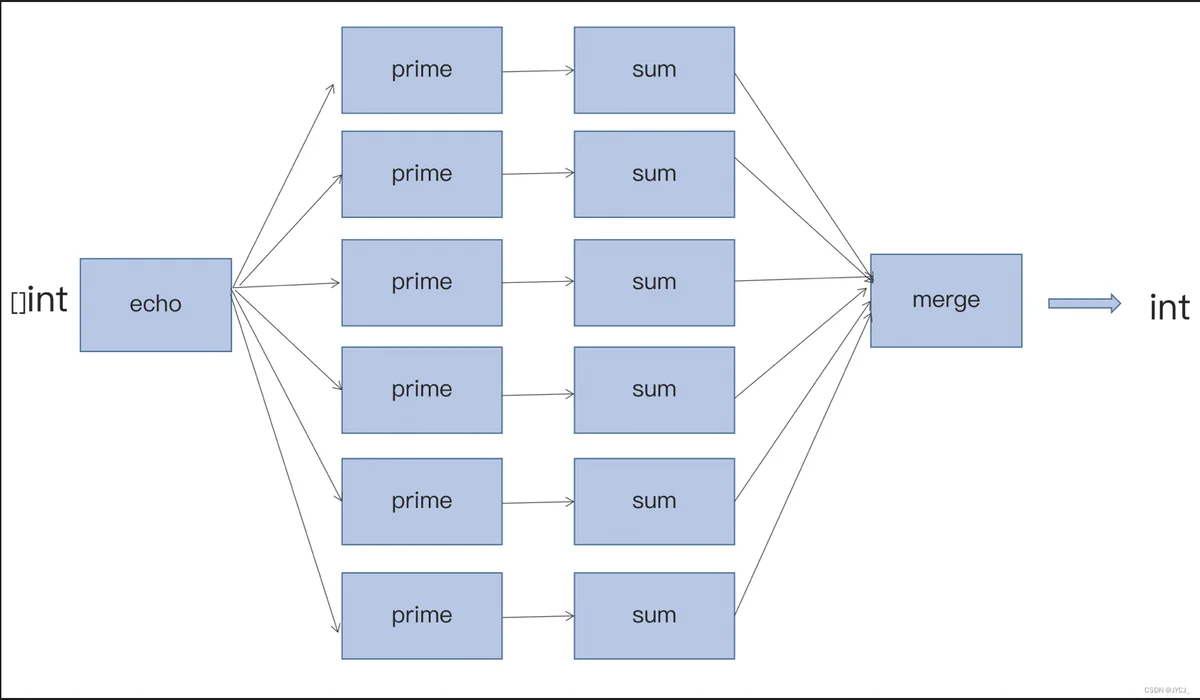
Kubernetes Visitor模式
Visitor 是面向对象设计模式中一个很重要的设计模式(可以看下 Wikipedia Visitor Pattern 词条),这个模式是将算法与操作对象的结构分离的一种方法。这种分离的实际结果是能够在不修改结构的情况下向现有对象结构添加新操作,是遵循开放 / 封闭原则的一种方法
Kubernetes 相关背景
我们再来了解一下相关的知识背景。
- Kubernetes 抽象了很多种的 Resource,比如 Pod、ReplicaSet、ConfigMap、Volumes、Namespace、Roles……种类非常繁多,这些东西构成了 Kubernetes 的数据模型
- kubectl 是 Kubernetes 中的一个客户端命令,操作人员用这个命令来操作 Kubernetes。kubectl 会联系到 Kubernetes 的 API Server,API Server 会联系每个节点上的 kubelet ,从而控制每个节点。
- kubectl 的主要工作是处理用户提交的东西(包括命令行参数、YAML 文件等),接着会把用户提交的这些东西组织成一个数据结构体,发送给 API Server。
- 相关的源代码在 src/k8s.io/cli-runtime/pkg/resource/visitor.go 中(源码链接)。
基本原理就是: 它从命令行和 YAML 文件中获取信息,通过 Builder 模式并把其转成一系列的资源,最后用 Visitor 模式来迭代处理这些 Reources。
Visitor 模式定义
type VisitorFunc func(*Info, error) error
type Visitor interface {
Visit(VisitorFunc) error
}
type Info struct {
Namespace string
Name string
OtherThings string
}
func (info *Info) Visit(fn VisitorFunc) error {
return fn(info, nil)
}
定义不同的visitor
// 这个 Visitor 主要是用来访问 Info 结构中的 Name 和 NameSpace 成员:
type NameVisitor struct {
visitor Visitor
}
func (v NameVisitor) Visit(fn VisitorFunc) error {
return v.visitor.Visit(func(info *Info, err error) error {
fmt.Println("NameVisitor() before call function")
err = fn(info, err)
if err == nil {
fmt.Printf("==> Name=%s, NameSpace=%s\n", info.Name, info.Namespace)
}
fmt.Println("NameVisitor() after call function")
return err
})
}
使用代码
func main() {
info := Info{}
var v Visitor = &info
v = LogVisitor{v}
v = NameVisitor{v}
v = OtherThingsVisitor{v}
loadFile := func(info *Info, err error) error {
info.Name = "BAlabala"
info.Namespace = "MegaEase"
info.OtherThings = "We are running as remote team."
return nil
}
v.Visit(loadFile)
}
结果输出(是不是有点思考不过来了?)
LogVisitor() before call function
NameVisitor() before call function
OtherThingsVisitor() before call function
==> OtherThings=We are running as remote team.
OtherThingsVisitor() after call function
==> Name=BAlabala, NameSpace=MegaEase
NameVisitor() after call function
LogVisitor() after call function
使用Visitor修饰器重构
type DecoratedVisitor struct {
visitor Visitor
decorators []VisitorFunc
}
func NewDecoratedVisitor(v Visitor, fn ...VisitorFunc) Visitor {
if len(fn) == 0 {
return v
}
return DecoratedVisitor{v, fn}
}
// Visit implements Visitor
func (v DecoratedVisitor) Visit(fn VisitorFunc) error {
return v.visitor.Visit(func(info *Info, err error) error {
if err != nil {
return err
}
if err := fn(info, nil); err != nil {
return err
}
for i := range v.decorators {
if err := v.decorators[i](info, nil); err != nil {
return err
}
}
return nil
})
}
info := Info{}
var v Visitor = &info
v = NewDecoratedVisitor(v, NameVisitorFunc, OtherVisitorFunc)
v.Visit(LoadFile)
